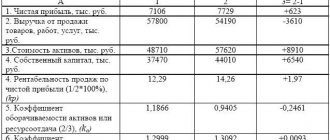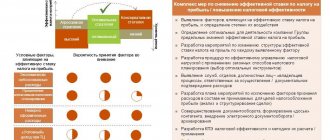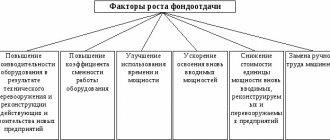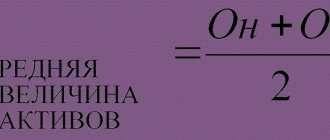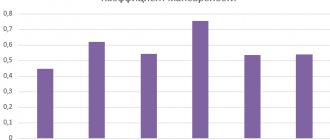What does the term "gross income" mean?
The concept of “gross income” is used by economists and accountants to evaluate the results of an organization’s activities. The gross income indicator makes it possible to evaluate the effectiveness of the team by calculating profit from it.
Gross income is the total amount of the company's revenue from the sale of:
- the goods and services it produces;
- real estate and other fixed assets;
- intangible assets;
- shares;
- intellectual property rights.
Gross income includes payments received from the rental of equipment or real estate, as well as other types of non-commodity services provided by the company. Gross income also includes other types of income (penalties, fines, irrevocable assistance, bank interest and much more). In trade, gross income is determined by the total revenue from the sale of goods.
For information on what relates to sales income, see the publication “Art. 249 of the Tax Code of the Russian Federation: questions and answers" .
For non-operating income, see the material “Art. 250 of the Tax Code of the Russian Federation: questions and answers" .
Set out the procedure for calculating gross income in the accounting policy of the enterprise. If you have access to ConsultantPlus, check whether you formulated this paragraph correctly. If you don't have access, get a free trial of online legal access.
Gross profit indicator as a business development tool
Calculation of gross profit is needed to analyze production resources and determine the overall profitability of the enterprise. The VP does not reflect actual income; the indicator is calculated without taking into account the costs of advertising, wages, rent or operation of the premises.
Important: data on total profit serves not specific, but general purposes. They are needed to identify immediate and future prospects for business development.
The main purpose of calculating gross profit is to reveal the weak and strong points in the production and economic structure of production in order to find ways to increase labor productivity and improve performance.
VP shows the need:
- Optimization of pricing policy.
- Elimination of unnecessary expenses.
- Improving work efficiency.
Important: gross profit is not a constant value. Proper coordination in the business world allows entrepreneurs to change it for the better.
Monitoring the dynamics of VP development allows you to see the practical results of the reforms carried out, draw up a schedule of financial and economic performance, identify profitable areas and eliminate obstacles to increasing profitability.
Formula for calculating gross income
Gross income is determined by the formula:
Inhalation = Ced × K,
Where:
Inhalation - gross income;
Tsed - the price of a unit of goods or services provided;
K is the quantity of goods sold or services provided. Calculation of gross income allows you to plan the directions of its subsequent distribution in order to ensure the self-sufficiency of the company. This, in particular, makes it possible to adjust selling prices to obtain better economic results.
Moreover, if accounting of commodity assets is carried out at purchase prices according to a quantitative-cost scheme, then the amount of gross income is determined automatically as the credit balance of account 90.1 “Revenue from the sale of goods.” If this condition does not apply, then the amount of gross income should be calculated using one of the formulas presented below.
Gross income in trade
Gross income in trade is calculated using the “Methodological recommendations for accounting” dated July 10, 1996 No. 1-794/32-5 approved by the Trade Committee of the Russian Federation. They (clause 12) provide formulas for calculating gross income for a trading company:
- by total trade turnover;
- taking into account the range of goods sold;
- at a determined average percentage;
- using the assortment of remaining goods.
Each trade organization has the right to use any of these formulas to calculate gross income from its practical activities. Gross income calculated using the average percentage formula is most often used in retail trade. This is the simplest gross income calculation of those listed earlier. To do this, use the gross income formula:
Inhalation = (STov × Pred) / 100,
Where:
Inhalation - gross income;
STov - the amount of trade turnover;
Avg - average percentage of premium.
The average percentage is calculated by using the trade margin values according to:
- balances of goods at the beginning of sales TNO (opening balance of account 42 “Trade margin”);
- goods received by consumer goods (credit turnover on account 42 for the period being calculated);
- disposed goods (damage, return) for the period of sales of Tnv (debit turnover on account 42).
Formula for calculating the average percentage:
Psred = (Tno + Tnp – Tnv) / (STov + Otov) × 100,
Where:
Otov - the balance of goods on the settlement date (credit balance of account 41 “Goods” at the end of the billing period).
Let's consider additional formulas for determining the amount of gross income from the sale of goods in more detail.
Additional formulas for calculating gross income from sales of goods
1. Formula for calculating gross income based on total turnover:
Inhalation = STov × RNats / 100,
Where:
RNats is the estimated trade margin, which is calculated according to the formula:
RNat = Tovn / (100 + Tovn),
Where:
Tovn - trade markup (%)
The formula for calculating gross income based on total turnover is used provided that all groups of commodity values have the same markup percentage. If its size changed during the billing period, it is more advisable to use other formulas.
2. Formula for calculating gross income for the assortment of remaining product values:
Inhalation = (Tno + Tnp – Tnv) – Tnk ,
Where:
TNK - markup at the end of the billing period (credit balance of account 42).
3. Formula for calculating gross income for the range of goods sold:
Inhalation = (STov1 × Medium1 + STov2 × Medium2….. STovN × MediumN) / 100,
Where:
STov(1...N) - trade turnover for a certain group of goods;
Average (1...N) - the average percentage of markup for each group of commodity values.
This method of determining the amount of gross income is used subject to keeping records of commodity values by groups of goods with the same markup percentage.
Gross income of a manufacturing firm
When producing products, a company calculates gross income based on the value received from its sale. Gross income here also characterizes the result of the company’s work on a certain date. To obtain a larger gross income, an analysis of prices, market conditions and demand for similar products is necessary.
Gross income may include not only income from sales of products, but also non-operating income, for example, from transactions with securities and other investment items. This may be income received from equity participation in other organizations, as well as other income in accordance with Art. 250 Tax Code of the Russian Federation.
For information on income and expenses during production and sales, see the publication “Art. 318 of the Tax Code of the Russian Federation: questions and answers.”
Principle of gross profit analysis
The analysis consists of studying the constituent elements of gross profit and searching for its further use.
At the first stage, the dynamics are studied through the terms of the VP. This is the so-called horizontal approach. At the next stage, a set of measures is formed to change the quality indicators of the components (vertical approach).
A detailed analysis includes a thorough examination of each element individually and all data together. Components and influencing factors are considered.
Postings: accounting for gross profit
Gross profit is shown in account 90 “Sales”. Account 90/9 is closed every month, writing off the balance to account 99 “Profits and losses”.
The account balance 90/9 shows the gross loss for the main activities. A credit account of 90 confirms the gross profit for the month. For account 90, second-order accounts (sub-accounts) are closed.
Formula for calculating VP
After the sale of goods, when summing up the results, a quantitative indicator of VP is calculated. The cash balance before tax expresses the degree of effectiveness of the management strategy, shows the effectiveness of the pricing policy, and shows the dependence of profitability on reducing production costs and reducing production costs.
The value is determined by the formula:
VP = D – (S + W);
Where VP is gross profit;
D - quantity of goods sold;
C is the cost of the product;
Z - production costs.
Note: Gross profit is usually calculated once a year.
Information about the profitability or unprofitability of controlled companies gives higher authorities a reason to liberalize taxation if it impedes the intensity of their development.
Calculation of gross profit using an example
The company produces electric irons. Production costs are 30,000 rubles, other costs are 15,000. Sales on average per day are 500 irons at a price of 1,000 rubles per product.
Attention: gross profit is the basis for planning the company’s future activities, taking into account the correction of shortcomings that hinder the increase in profitability.
To calculate VP, daily revenue is calculated: the number of irons sold is multiplied by the cost of one piece. They receive 500,000 rubles. From this amount, production costs and production losses are subtracted, amounting to a total of 45,000 rubles. Subtract 45,000 from 500,000 to obtain 455,000 rubles of gross profit.
Specifics of calculation depending on the type of enterprise
An enterprise selling its products displays gross profit after deducting all expenses. In addition to cost, these include discounts and product returns. The difference between revenue and expenses shows gross profit.
Help: the calculation algorithm is common to all enterprises.
The gross profit of a company providing services is calculated without taking into account the cost of production. Discounts and other similar expenses are subtracted from daily revenue. The remainder shows gross profit.
Results
Any commercial activity is created with the aim of making a profit. Profit is the difference between gross income and costs incurred. The amount of gross income is determined by the formula. There are several formulas for calculating gross income, and each company chooses the option that suits its needs.
Sources: Tax Code of the Russian Federation
You can find more complete information on the topic in ConsultantPlus. Full and free access to the system for 2 days.
General characteristics and significance of gross profit for production development
Competent management of the production and commercial activities of any enterprise is impossible without regular monitoring of financial indicators.
To monitor the turnover of funds, financial statements are generated. Gross profit is one of the significant indicators of a company's economic potential.
The indicator expresses the financial result of all aspects of the company's activities. The value is reflected in the balance sheet.
The total value expresses the influence of external and internal parameters on the success of the enterprise. For convenience, they are divided into 2 groups.
The first shows the dependence of VP on the organization within production.
Its value is influenced by such parameters as:
- Cost of production.
- Commodity coefficient.
- Volume of production.
- Product quality.
- Degree of utilization of production capacity.
In addition to these intra-production reasons, the increase or decrease in gross profit is influenced by environmental parameters.
Among them are:
- Location of the company.
- Regulatory framework.
- Political and economic situation in the country.
- The natural environment.
Analysis of the parameters that affect the amount of gross profit is necessary to make a decision on the feasibility of a particular type of activity in a particular region. With the help of this tool, profitable or unprofitable areas of business are identified, and guidelines for new ways to solve financial problems are obtained.


